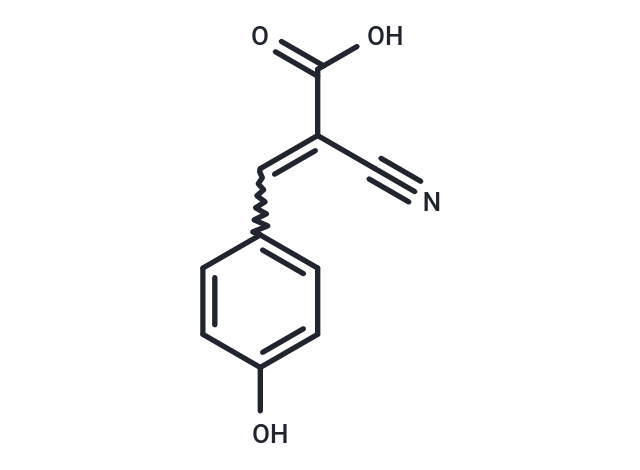Shopping Cart
- Remove All
 Your shopping cart is currently empty
Your shopping cart is currently empty


| Pack Size | Price | Availability | Quantity |
|---|---|---|---|
| 50 mg | $45 | In Stock | |
| 100 mg | $64 | In Stock | |
| 200 mg | $94 | In Stock | |
| 1 mL x 10 mM (in DMSO) | $39 | In Stock |
| Description | α-Cyano-4-hydroxycinnamic acid (α-CHCA) is an inhibitor of monocarboxylate transporter 1 (MCT1), which blocks pyruvate transport in rat heart mitochondria (IC50: 1.5 μM). |
| In vitro | The effectiveness of CHC in glioma cells appears to be dependent on Monocarboxylate transporters (MCTs) membrane expression.?MCT1 downregulation showed similar effects on different glioma cells, supporting CHC as an MCT1 inhibitor.?There was a synergistic effect when combining CHC with temozolomide treatment in U251 cells.?In the CAM in vivo model, CHC decreased the size of tumors and the number of blood vessels formed[1]. |
| Cell Research | Cells were plated into 96-well plates, at a density of 3 × 10^3 cells per well.?The effect of treatment with CHC (0.6–12 mM) on cell number (total biomass) was determined at 24, 48, and 72 h by the?sulforhodamine B assay (SRB, TOX-6).?IC50 values (CHC concentration that corresponds to 50% of cell growth inhibition) were estimated from 3 independent experiments, each one in triplicate, using GraphPad Software.?Cell proliferation assay was performed as previously described32 and assessed under the treatment conditions previously described, for 5 mM and 10 mM of CHC.?After CHC treatment, cells were incubated with BrdU and its incorporation was assessed at 450 nm (λref = 655 nm) .?Cell growth (total biomass) and cell proliferation for glioma siMCT1 cells and the effect of CHC (1.25–15 mM) on cell number were performed[1]. |
| Alias | α-Cyano-4-hydroxycinnamic acid(α-CHCA) |
| Molecular Weight | 189.17 |
| Formula | C10H7NO3 |
| Cas No. | 28166-41-8 |
| Storage | Powder: -20°C for 3 years | In solvent: -80°C for 1 year | Shipping with blue ice. | |||||||||||||||||||||||||||||||||||
| Solubility Information | DMSO: 37 mg/mL (195.59 mM) | |||||||||||||||||||||||||||||||||||
Solution Preparation Table | ||||||||||||||||||||||||||||||||||||
DMSO
| ||||||||||||||||||||||||||||||||||||

Copyright © 2015-2024 TargetMol Chemicals Inc. All Rights Reserved.